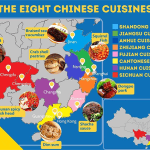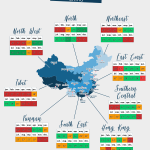There are many eating manners that one must pay attention to which date from the time of ancient China, such as how to sit in a banquet or the layout of the place settings. Etiquette governs much of one’s conduct at the table. Some rules were out of courtesy and identity, and were called by ancient Chinese “respect for manners”; some others were traditional; and some only concerned the behaviors of certain groups of people (especially women) and were actually not necessary. Whatever their origin, these rules show ancient China’s dietary habits and food culture, and some of them are still followed in modern Chinese life. Compliance with these rules sometimes signals a person’s status, culture, and family education to others. Because the custom of using banquets to solve problems in business, for friendship, and even in officialdom by the Chinese people, one should pay attention to manners at the table and especially to the Chinese eating taboos
Table and place settings
Both square and rectangular tables are used for small groups of people. When large groups are dining, particularly in restaurants, round tables are common. Because dishes are communal in Chinese dining, large tables make reaching food difficult. For this reason, the Lazy Susan is a common feature.
A basic place setting consists of a small teacup, a large plate with a small, empty rice bowl in the centre, a set of chopsticks on the right hand side of the table, and a spoon. More elaborate place settings may include a chopstick holder, a water- or red wine style glass, and a small baijiu glass.
At each place setting, a cloth napkin may be present. It is ordinarily placed under the place setting, diagonally, so that it appears as a diamond shape to the diner. Unlike formal Western dinners, a cloth napkin is not placed on the lap. Instead, whether provided by the hosts or waitress, or already present, folded at the place setting, it is to be placed with one corner under the large plate of the place setting, and the rest hanging down diagonally over the edge of the table, and partially onto the lap of the diner.
Also present on the table, for communal usage, are toothpicks, and paper napkins. It is polite, when taking a napkin for oneself, to provide one to guests seated next to you.
Courses

Snacks
Snacks are the first items to be present. Two or more small plates are brought to the table. They may include boiled unsalted peanuts, salted roasted peanuts, pickled vegetables or other dishes. These may be consumed while waiting for other dishes to arrive, or in the case of restaurant meals, during ordering.
Beverages
Tea is always provided, either in advance of the diners being seated, or immediately afterward. It can be consumed at leisure throughout the meal. Water is sometimes served, but tea is the normal substitute.
Unlike the West, at restaurant meals, drink orders are not taken first. They are ordered at the same time as ordering food, and will arrive only after ordering is complete. With the exception of tinned soft drinks, most beverages are served by the pitcher or large bottle.
Juices, such as corn or watermelon juice, are served by the pitcher, and are usually provided before main dishes.
If beer is ordered, it is normally brought to the table area after all ordering is done, but placed on a side table, often several bottles at a time. These are not provided to individuals, but will, when served, be communal. Beer will not normally be consumed until main dishes arrive.
If diners will consume baijiu, an entire bottle, usually brought by the diners themselves is placed on the table at the time everyone is seated. This is opened and poured, normally only to adult men, before dishes arrive. Some may be consumed before main dishes arrive, but not always.
Main course
This consists of many dishes, usually roughly one dish per person, or more. These are eaten communally.
Soup
Not always served, but common in restaurant dinners with many guests, soup is served. This is normally a clear soup with containing a small amount of meat, but may also be a thick, vegetarian soup.
Dumplings, noodles, or baozi
Near the end of the meal, a starch dish is sometimes served.
Dessert
A common dessert is fruit plates with toothpicks in each piece. Other desserts include red bean soup, rice soup, and almond tofu
Manners and customs
Eating is a dominant aspect of Chinese culture, and in China, eating out is one of the most common ways to honor guests. Similar to Westerners, eating together in China is a way to socialize and deepen friendships.
Table etiquette is very important to Chinese people. In Chinese culture, using correct table manners is believed to bring “luck” while incorrect use will bring shame. Similarly, table etiquette indicates children’s educational status: holding chopsticks incorrectly leaves a bad impression and shames the parents, who have the responsibility of teaching them.
Inviting guests
There are many traditions that govern table manners in China, such as the correct treatment of guests and how to correctly use chopsticks. Although each household has its own set of table manners and rules, the foundational traditions used to welcome guests are the same.
There are common rules for inviting guests over. When the guest of honor enters into the room, the hosts stand until the guest of honor is seated. The host then orders the dishes brought, and the guest should be silent. When the dishes arrive, the meal begins with a toast from the host, and the guests then make a toast in turn in the honor of the host. The guest of honor should be the first one to start the meal. The best food in a dish should be left for the guest of honor.
Seating
Seating arrangement is one of the most important part of Chinese dining etiquette. Dining etiquette in ancient times was enacted according to a four-tier social strata: 1. the imperial court, 2. local authorities, 3. trade associations and 4. farmers and workers. The respect structure in modern dining etiquette has been simplified to: 1. master of the banquet and 2. guests.
The seat of honor, reserved for the master of the banquet or the guest with highest status, is the one in the center facing east or facing the entrance. Those of higher position sit closer to the master of the banquet. The guests of lowest position sit furthest from the seat of honor. When a family holds a banquet, the seat of honor is for the guest with the highest status and the head of the house takes the least prominent seat.
If round tables are used, the seat facing the entrance is the seat of honor. The seats on the left hand side of the seat of honor are second, fourth, sixth, etc. in importance, while those on the right are third, fifth, seventh and so on in importance, until they join together.
Dining
Eating
With some exceptions, hands should never be used to handle food. Even with pieces of meat, too large to eat in one bite, and containing bones, must be brought to the mouth using chopsticks (or in some cases, a spoon). When a large piece of meat is brought to one’s mouth, it should be held firmly in the chopsticks, and the meat eaten from it. If it is small enough to fit within the mouth, the diner is expected to place the entire piece into the mouth, and must remove the meat therein. As the Chinese typically eat cartilage and connective tissue, it is easier to eat all but the bone, than if only the meat were to be removed. The bone is then spat out onto the side of the large plate, or onto the table, beside the diner, without the aid of hands or chopsticks. This is a common sight when eating fish. Diners will continuously spit out small bones.
Steamed rice is not normally served at the beginning of the meal. Food is placed into the small, empty bowl, and eaten without accompaniment. Then, after the meal is underway, steamed rice may be ordered by many of the diners. When it arrives, the small bowl is replace with the steamed rice bowl. Henceforth, food taken from dishes in the centre of the table is placed on top of the steamed rice.
During the dinner service, a waitress (almost invariably female throughout China), will replace the large plate with a clean one, and often remove used paper napkins with tongs.
Drinking
Water and other non-alcoholic beverages may be consumed at anytime. However alcohol must be consumed only during toasts. If that beverage is beer, then an ordinary amount is consumed, such as a few swallows. In the case of grape wine, a single sip is common. If the toast is being made with a small glass of baijiu, then the toast may call for “gan bei”, literally “dry glass”.
Toasting
Men, women, and children participate in the custom of toasting. It entails a single person engaging one, two, or all of the guests, by holding up a glass. During the first toast of the night, particularly when including everybody present, all stand. The initiator will sometimes make a preamble, and may say “gan bei”, literally “dry glass”, the equivalent of “bottoms up”. This means that the participants are all expected to finish the entire drink. Women and children do not normally drink alcohol, but nevertheless will participate in the toast with whatever beverage they have. Then everyone drinks. If the beverage is other than a small glass of baijiu, “gan bei” is not said. Instead, “thank you for coming” or something similar is said. After, and often during the toast, eye contact and a smile is customary. After a “gan bei”, the empty glass is sometimes shown to prove that all was consumed.
At once, the glass is refilled awaiting the next toast. Whether baijiu, grape wine, or beer is being consumed, the glass is never left empty.
If the guests are few in number, or are seated at a small table, touching glasses is common. But, at a large table, or when the toastees are too great in number or too far away, this is impossible. Then, simply raising a glass is acceptable. A variant is to tap the bottom of the glass on the table, whereafter the toastee will do the same. This acts as a substitute for touching glasses.
Throughout the dinner, toasts are made. With guests of honour, the host, or others, a visit to their seat for a personal toast is customary.
It is customary, some time after being toasted, to initiate a toast to the same group or individual in return.
When a guest of honour is present, who is not elederly, or of considerably greater social or economic status, a tactic of individual toasts is sometimes employed. The diners will collude to deliberately toast that person one-on-one, in order to cause that person to become drunk.
Birthday noodles

Meaning: It symbolizes longevity.
In this case, that long strip of noodle is a metaphor for the long walk of life. Yet this tradition comes with an addendum: do not cut the noodles.
“That symbolizes cutting your life off,” says Lo. It’s not a very positive message on the day of one’s birth.
Thankfully, cutting applies mainly to severing with a knife or with chopsticks. Biting is a practical and, Lo says, acceptable way of ensuring you don’t look like a hamster with filled cheek pouches.
“You should slurp your noodles,” Lo adds. “That means it tastes good. It’s like swishing wine in your mouth so that it mixes with oxygen — it’s the same idea
Chopstick usage

Since chopsticks are often used in many dishes in Chinese cuisine, knowing correct chopsticks usage is essential. The most common chopsticks usages are the following:


















The bill

Guests should not truly “split the bill” with the host. A guest who “split(s) the bill” is very ungracious and embarrassing to the host. If you do not accept the host paying for the bill, it is implying that the host cannot afford it or you do not accept the friendship or hospitality of the host. However, it is expected for the guest to offer to pay for the meal multiple times, but ultimately allow the host to pay. It is also unacceptable to not make any attempt to “fight for” the bill. Not fighting for the bill means you think that the host owes that meal to you somehow. Therefore, if you are the guest, always fight for the bill but never win it on the first meal in your host’s hometown. After the first meal at your host’s hometown, and sometime before you leave, it is customary to bring the host’s family to a meal out to thank them for your stay if you did not bring initial small presents for them when you arrived. For that meal, you may pay, but you must request your host’s attendance and cooperation with your covering the bill.
If you and an acquaintance are on a business trip, it is acceptable to split the bill, but more common to rotate who pays for the meal, with meals of similar cost. Though it is a rotation, there is still the same mock-fight for the bill. The difference is that you may say, “Fine fine, since you are my elder, this is fine this time, but the next meal, I cover.” Or something to that effect and pay for the next meal. This rotation does not have to be a meal necessarily. For example, you may rotate a meal and a game of golf. The key to the rotation being viewed as acceptable or not, is the enjoyment both parties actually get from the activity, and the approximate cost. Golf would not be an acceptable rotation if the other person does not enjoy golf, is rather bad at it while you are excellent at it, etc.






















 Online | Privacy policy
Online | Privacy policy